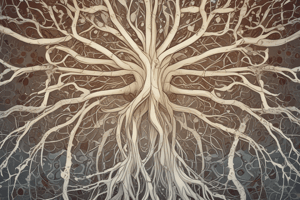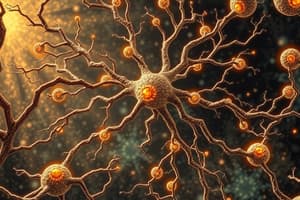Podcast
Questions and Answers
Which of the following is NOT a key factor in establishing resting membrane potential?
Which of the following is NOT a key factor in establishing resting membrane potential?
- The concentration gradient of potassium ions (K+) across the membrane
- The concentration gradient of sodium ions (Na+) across the membrane
- The permeability of the membrane to sodium ions (Na+) (correct)
- The permeability of the membrane to potassium ions (K+)
What is the primary function of oligodendrocytes in the central nervous system?
What is the primary function of oligodendrocytes in the central nervous system?
- Remove waste products from the nervous system
- Form the myelin sheath around axons (correct)
- Maintain the blood-brain barrier
- Provide structural support for neurons
Which type of axoplasmic transport moves materials from the soma to the axon terminal?
Which type of axoplasmic transport moves materials from the soma to the axon terminal?
- Retrograde transport
- Diffusion
- Anterograde transport (correct)
- Passive transport
Which of the following is a characteristic of electrical synapses?
Which of the following is a characteristic of electrical synapses?
What is the role of calcium ions (Ca2+) in neurotransmitter release?
What is the role of calcium ions (Ca2+) in neurotransmitter release?
What is the function of the Nernst equation?
What is the function of the Nernst equation?
Which of the following describes the process of myelination?
Which of the following describes the process of myelination?
What is the function of the sodium-potassium pump?
What is the function of the sodium-potassium pump?
Flashcards
Neuron Doctrine
Neuron Doctrine
The concept that neurons are the fundamental unit of the nervous system.
Types of glial cells
Types of glial cells
Supportive cells in the nervous system, including astrocytes, oligodendrocytes, and microglia.
Axoplasmic transport
Axoplasmic transport
The process of transporting materials along the axon, divided into anterograde and retrograde transport.
Resting membrane potential
Resting membrane potential
Signup and view all the flashcards
Action Potential
Action Potential
Signup and view all the flashcards
Synaptic Vesicle Fusion
Synaptic Vesicle Fusion
Signup and view all the flashcards
Nernst Equation
Nernst Equation
Signup and view all the flashcards
Dendritic Arbors
Dendritic Arbors
Signup and view all the flashcards
Study Notes
Neuron Doctrine and Nervous System Components
- The neuron doctrine describes the fundamental unit of the nervous system as a neuron.
- Different cell types exist within the nervous system, including neurons and glial cells.
- Neurites are extensions of neurons, including axons and dendrites. Axon collaterals are branches of an axon, and recurrent collaterals are axon branches that return to the neuron.
- The neuron's cytoskeleton is crucial for its organization and function.
Axoplasmic Transport and Neuron Connections
- Axoplasmic transport involves moving materials within axons.
- Dendrites and axons synthesize proteins differently compared to the soma (cell body).
- Neurons connect in various ways, forming different types of connections.
- Dendritic arbors are intricate branched structures that receive inputs from other neurons. They regulate the amount of input a neuron receives.
Nervous System Structure and Function
- Glial cells, including different subtypes (e.g., astrocytes, oligodendrocytes, microglia) carry out essential roles in the nervous system.
- Neural circuits are interconnected pathways of neurons.
- The neuron membrane has unique compositional properties relevant to its function.
- Ion transport mechanisms are vital for various neural processes.
Action Potential and Synaptic Transmission
- Key factors establish the resting membrane potential.
- The Nernst and Goldman equations are important in understanding membrane potential.
- Action potentials are characterized by distinct phases (resting, depolarization, repolarization etc).
- The action potential is propagated along the axon.
- Voltage-gated ion channels (Na+ and K+) play a crucial role.
- Synapses are junctions between neurons; two main types exist.
- Synaptic vesicle fusion and neurotransmitter release are integral to synaptic transmission.
- Postsynaptic receptors on the receiving neuron have unique characteristics and functions.
Neurotransmitter Classification and Function
- Neurotransmitters are crucial for neuronal communication.
- Various criteria classify neurotransmitters.
- Different methods classify neurotransmitters.
- The synthesis of neurotransmitters (e.g., acetylcholine, catecholamines, serotonin, amino acids) follows unique pathways.
- Excitatory and inhibitory neurotransmitters have different effects on the postsynaptic neuron.
Studying That Suits You
Use AI to generate personalized quizzes and flashcards to suit your learning preferences.




